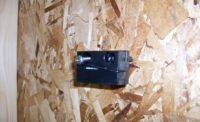Climate Driven R-Value Research

This industrial building in Chilliwack, British Columbia is being used as a research ground to determine how various insulation materials and membrane color can affect the thermal performance of the building. Seen here, the different membrane colors are given equal space and their performance is monitored consistently.

This industrial building in Chilliwack, British Columbia is being used as a research ground to determine how various insulation materials and membrane color can affect the thermal performance of the building. Seen here, the different membrane colors are given equal space and their performance is monitored consistently.
















A large-scale field monitoring study was implemented in the Lower Mainland of British Columbia with the intent of measuring the impacts and benefits of roof membrane color, and insulation strategy on the long-term thermal and hydrothermal behavior and performance of conventional roofing assemblies.
Three different 2-ply SBS roof membrane cap sheet colors were installed over three different insulation arrangements for a total of nine unique test roof assemblies, which were installed on an industrial building located in Chilliwack within the Lower Mainland of British Columbia, Canada. Chilliwack is located in ASHRAE Climate Zone 4 and has a climate similar to the larger nearby metropolis of Vancouver, though as it is farther inland, it typically gets hotter in the summer and colder in the winter.
The average annual temperature at the Chilliwack airport, located approximately 1 km (0.6 miles) from the site is 10.5 degrees Celsius (50.9 degrees Fahrenheit), and the average July and January temperatures are 18.5 degrees Celsius (65.3 degrees Fahrenheit) and 2.2 degrees Celsius (36.0 degrees Fahrenheit) respectively (Environment Canada 2013). Sensors were installed within each of the roof assemblies to measure material and surface temperatures, relative humidity, moisture content, heat flux, and dimensional stability of the insulation.
Insulation Arrangement Apparent R-values
Laboratory measurements were made of the apparent R-value/inch for each insulation product, and then the results were used to determine the apparent R-values of the three insulation arrangements for this study, which are shown on page 23.
By measuring both new and aged samples of polyisocyanurate (polyiso) insulation, the long-term aging impacts on the thermal performance of the polyiso were also predicted. This plot demonstrates the sensitivity of the apparent R-value of the different roof assemblies when exposed to either extreme cold or hot outdoor temperatures.
While the roof assembly constructed with polyiso has a rated R-value of R-21.3, when exposed to cold (-10 degrees Celsius (14 degrees Fahrenheit)) the performance of this roof assembly reduces to R-20 or potentially as low as R-16.5 depending on aging effects. When exposed to hot temperatures (60 degrees Celsius (140 degrees Fahrenheit)), the apparent R-value is reduced to R-16.5 or potentially as low as R-14.0 depending aging effects. In the hybrid assembly, the use of a layer of stone wool insulation (in this case, equivalent to approximately 45 percent of the assembly R-value) over top of the polyiso significantly improves the effective R-value of the polyiso as it keeps it near optimum temperatures (which are similar to typical interior temperatures), and therefore results in a better assembly R-value in cold and hot conditions. The roof assembly insulated with entirely stone wool insulation has a more stable R-value (increasing at colder temperatures, but decreasing at hot temperatures from rated R-value) and is not susceptible to a loss of R-value with age.
Details of the Assemblies
Polyisocyanurate Roof Assembly
- SBS Cap Sheet
- SBS Base Sheet
- Asphalt Protection Board
- 2-inch Polyiso Insulation
- 1 ½-inch Polyiso Insulation
- Air/Vapour Barrier (bituminous SAM)
- Metal Deck
Stone wool Roof Assembly
- SBS Cap Sheet (White, Grey, Black)
- SBS Base Sheet
- Asphalt Impregnated Surface
- 2 ½-inch Stone Wool Insulation (Top)
- 3 ¼-inch Stone Wool Insulation (Bottom)
- Air/Vapour Barrier (bituminous SAM)
- Metal Deck
Hybrid Roof Assembly
- SBS Cap Sheet (White, Grey, Black)
- SBS Base Sheet
- Asphalt Impregnated Surface
- 2 ½-inch Stone Wool Insulation (Top)
- 2-inch Polyiso Insulation (Bottom)
- Air/Vapour Barrier (bituminous SAM)
- Metal Deck
Field Monitoring Results
The field monitoring component of this study has found large differences in heat flux and the interior and exterior surface temperatures due to light to dark membrane color. Significant differences in the heat flux and interior and exterior surface temperatures were also found with respect to insulation strategy, which is a finding unique to this study. An apparent thermal lag is observed within the stone wool insulation and hybrid insulation assemblies compared to the polyiso insulation. This finding presents as dampened heat flux measurements, reduced cap sheet surface temperatures, and lower interior surface temperatures, primarily when the roof is heated by the sun. At night, the differences between the assemblies are very small.
This thermal lag is caused by a combination of the temperature dependency of the polyiso insulation, as well as the increased thermal mass of the stone wool insulation as compared to the polyiso (approximately 3.4 times greater), and may also be impacted by latent heat transfer through the assembly.
This lag in temperatures can be beneficial from a thermal comfort, energy efficiency, and membrane durability standpoint because it moderates peak temperatures and thereby reduces energy losses and gains and likely also reduces the rate of deterioration of the membrane by reducing chemical degradation and thermal movement.
In summary, the lowest amount of inward heat flux occurs with the stone wool assemblies followed by the polyiso and then the hybrid insulation assemblies due to the combination of the effects of temperature dependent R-values of the insulation, increased thermal mass of the stone wool insulation (as compared to the polyiso), and potentially latent heat transfer. The assemblies with a white cap sheet also typically had less inward heat flux than the black and grey roofs.
Selection of Roofing Membrane Color and Insulation Strategy
Whole building energy modelling was performed to investigate the optimum roof membrane color (solar absorptivity) and insulation strategy for a conventional roof. Simulation runs were used to compare the same white, grey, and black roof membranes, and polyiso, stone wool, and hybrid insulation strategies as used in the monitoring study. Though the overall difference in heating energy consumption between the two cases is low (generally within 1 kwh per meters squared (320 Btu per square foot) per year) the results show that polyiso has the lowest heating energy consumption when constant R-values are used, but stone wool has the lowest heating energy when the more accurate temperature dependent R-values are included. This is an important finding for energy modelers and needs to be addressed by the default insulation material properties within energy modeling programs.
Comparing roof membrane color across each climate zone, the black membrane uses less heating energy but more cooling energy, while the white roof uses less cooling energy but more heating energy. Overall energy use is lower for white roofs in cooling dominated climate zones (zones 1 and 2), and lower for black roofs in heating dominated climate zones (zones 5 through 8). In mixed heating and cooling climate zones (zone 3 and 4), the differences are very small between light and dark colored roof membranes. With membrane aging and dirt soiling, the cooling savings of white membranes will be reduced as the surface reflectivity decreases. The impact of membrane soiling and aging is being monitored as part of this study but is not presented within this paper.
Conclusions & Recommendations
This study was implemented with the intent of measuring the impacts and benefits of roof membrane color and insulation strategy on the long-term thermal and hygrothermal behavior and performance of conventional roofing assemblies. At the study building in the Lower Mainland of British Columbia, Canada, three different 2-ply SBS membrane cap sheet colors (white, grey, black) were placed over three different conventional insulation strategies (polyiso, stone wool, and hybrid combination of both), creating a total of nine unique conventional roofing assemblies.
Reduced peak temperatures were measured for the stone wool and hybrid assemblies as compared to the polyiso assembly due to the combined effect of temperature dependent R-values, insulation thermal mass, and latent heat transfer. These lags work to offset peak heat transfer and also affect the longevity of the membrane. Reduced peak interior temperatures also typically improve occupant comfort. In addition, stone wool has a more stable R-value than polyiso for the same installed R-value (note that installed R-value is different than thickness) so it insulates better when exposed to larger temperature differences, as can frequently be experienced on roofs, and results in reduced building energy consumption as was confirmed using whole building energy modeling.
The membrane color was also measured to have a large impact on peak temperatures and heat flows through the roof assemblies, with the white membrane experiencing lower maximum temperatures than the grey and black membranes. This reduction in roof temperature was also found to have an impact on the energy consumption of the buildings. In heating dominated climates black membranes were found to minimize building energy consumption by increasing heat gains to the building, while in cooling dominated climates white membranes were found to be optimal.
Overall, this study provides insight into the behavior of polyiso and stone wool insulated conventional roof assemblies with light to dark roofing membranes. In selecting the materials for a conventional roofing system it is important to consider the effects of these different options on aspects of building and roof performance including apparent R-value at in-service conditions, building energy consumption, and membrane durability. The study is ongoing and will continue for the next few years.
Looking for a reprint of this article?
From high-res PDFs to custom plaques, order your copy today!














